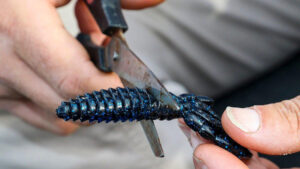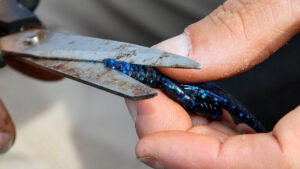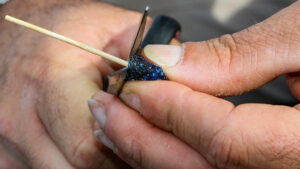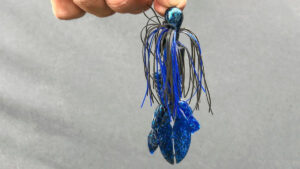Chunk style trailers are generally intended for the more subtle bass fishing skirted jig presentations when you’re not looking for rocket-fast falls or exaggerated motion. Nevertheless, Bassmaster Elite Series pro Todd Faircloth combines this modest appearance with good movement in a swinging trailer skirted bass fishing jig.
He compares it to that of a swing set versus a merry-go-round.

Faircloth favors a Strike King Rodent, or the Baby Rodent for finesse jigs. In either case, he takes a different approach than the traditional route of threading the bait onto the jig hook. He opts for a free-swinging arrangement, which he accomplishes by impaling his jig hook through the bait laterally.
“It’s subtle, but it looks more lifelike,” Faircloth said. “That’s why pork shines in cold months.”

His first step in prepping his jig trailer involves cutting the body down to about a half inch. This allows him to maintain the kind of compact profile that appeals to bass in cold, or otherwise tough conditions.
Next, Faircloth applies a little soft plastic sculpting to the trailer’s freshly cut top edge. With precise snips, he removes angled chunks of plastic until he’s created a blunt point.

“I like to trim that top point because it’s more streamlined and flows through the water better,” he said.
With his shaping completed, Faircloth then fortifies the trailer to hold its position on the jig’s hook. Starting at one of the Rodent’s narrow sides, he inserts a toothpick lengthwise across the plastic body — about 1/16- to 1/8-inch down from to top edge.
This creates a catch point that prevents the hook from pulling out of the trailer. Breaking off both ends of the toothpick keeps it concealed within the plastic.

“Inserting the hook behind that toothpick creates a strong connection,” Faircloth said. “A lot of times, you can fish one jig trailer halfway through the day, depending on how many fish you’re catching.
“It makes you more efficient as an angler, you get more casts in during the day and you save a few baits, too.”
Last benefit Faircloth notes is one of symmetry; or, in this case, a lesser regard for such.
“If you thread a trailer on a jig, it has to be straight,” he said. “During the course of the day, if you make a cast, or you’re skipping a jig under a dock, you may crook that trailer a little bit and your jig just isn’t going to look as natural in the water.
“A free-hanging trailer is pretty much where it’s going to be. It’s in the dead center of that deal where you hook it and it’s going to look more lifelike more of the time.”













